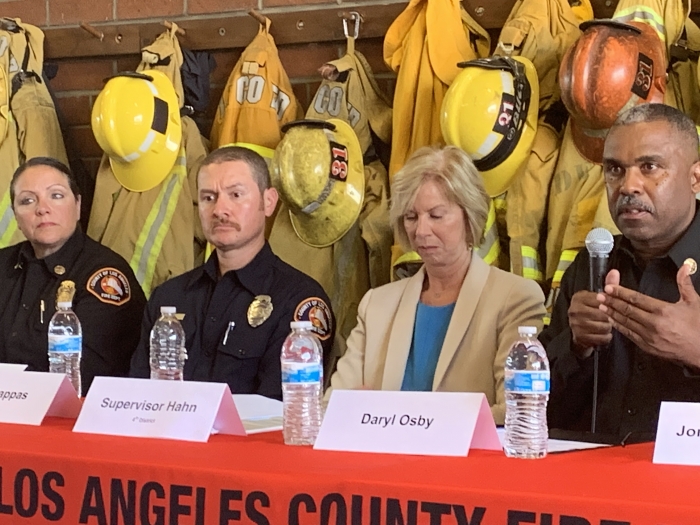
On August 1, the Los Angeles County Fire Department (LACoFD) held a press briefing at Station No. 31 in Paramount to discuss its most pressing challenges in the face of a growing call volume and intensifying wildfires. Fire Chief Daryl Osby and Assistant Fire Chief Eleni Pappas sat on a large panel of firefighters and paramedics, who shared their stories from the frontlines. Los Angeles County Supervisor Janice Hahn also spoke on the panel, urging the media to inform the public of their role in improving the fourth-busiest fire department in the country.
Supervisor Hahn opened the event by speaking about her father, Kenneth Hahn, who also served on the Los Angeles County Board of Supervisors for 40 years and played a crucial role in the creation of the modern paramedic program during the late 1960s. She explained how it took Mr. Hahn several years of fighting serious opposition from doctors, nurses, then California Governor Ronald Reagan, and even his own fire chief to convince people that firefighters should be able to administer treatment in the field. This was a practice Mr. Hahn rightly believed would increase the survival chances of those who suffered medical emergencies, particularly heart attacks.
“It’s hard to imagine a time before we had paramedics, before we could expect a highly-trained and capable paramedic to come to our aid when we were hurt or sick,” Supervisor Hahn said. “We take these life-saving services for granted these days.”
The extent to which the paramedic program has transformed the role of the fire department over the past 50 years is quite staggering. Today, Hahn said, 84 percent of calls to the county fire department are for medical emergencies such as strokes, car accidents and heart attacks. Unfortunately, while these types of calls have increased by 50 percent since 2008, fire department staffing and resources have not kept up. The number of paramedic squads, Hahn said, have increased by only 5 percent within the same time frame. Moreover, their jobs are made increasingly difficult by limited finances and aging equipment.
“These are serious problems, and if we want to continue to offer the excellent emergency medical services and fire protection that we provide today to our residents, we have to address this resource problem,” Hahn said. “And to do that, we need our residents to understand the roots of this problem.”
During his speaking time, Chief Osby addressed how those problems directly affect firefighters on the ground. According to Osby, it has been three years since the department was last able to purchase new equipment for firefighters and paramedics such as vehicles, thermal imaging cameras, heart monitors, and more. Stretched thin by understaffing, county firefighters have had to “do more with less.” They are cross-trained to respond to a variety of scenarios including medical emergencies, structural firefighting, urban search-and-rescue and HazMat firefighting. While the national standard for the number of firefighters staffing a firetruck is four, two-thirds of Los Angeles County firetrucks are staffed with only three.
Osby also explained how worsening climate conditions have provoked more frequent and severe wildfires, rendering LACoFD unable to rely on neighboring departments for assistance when needed. During the Woolsey Fire last November, Osby said, firefighters from Northern California (who would usually be able to help during that typically rainy time of year) could not come to the aid of LACoFD because they were fighting the Camp Fire. LACoFD was forced to make the most of what it had, with several firefighters working over 40 hours straight to evacuate citizens and put out the flames.
“I cannot begin to tell you the stress and the impact that has on our firefighters and our paramedics as it relates to that workload,” Osby said.
Eleni Pappas, Los Angeles County’s first female assistant fire chief, spoke next. As the daughter of immigrants, she said, she felt obliged to address how incredibly important the fire department is to Los Angeles County’s immigrant communities.
“I’m the operational commander of Division VI, and we have the most densely populated and urbanized communities within the county, right here in this area,” Pappas said. “And we have a lot of immigrant, hard-working families that are underserved, who don’t necessarily have opportunities for healthcare. And what we see is, we are the safety net for those communities.”
Often, she said, people will call the department when they feel unwell, and paramedics transport them to a hospital where they are able to get the proper care they need for the first time. Had they not called 911, they may have never received that care at all.
Pappas also touched on the mental and emotional toll that this work takes on firefighters. She said she has, on multiple occasions, pulled firefighters out of service in order to process the psychological trauma of a gruesome sight they encountered in the field. The department has even brought in mental health professionals on occasion.
Both Osby and Pappas acknowledged the steadfastness of the department’s firefighters in the face of these challenges. Through it all, they said, their men and women have continued to show up and bravely do the best they can to save as many lives as possible. That said, under the pressure of increasing calls and deadlier fires, LACoFD must seriously consider how to best allocate its funding in the future – and it wants county citizens to have a say in the matter.
Recruitment has been a main priority in the department’s public outreach, and as the first African American fire chief of LACoFD, Osby aims to create diversity in the fire department to match that of the county.
“Diversity is a plus because it allows our internal team to have life experiences and perspectives from wherever they come from to help the department provide better training internally, better understanding internally the constituents that we provide services to,” Osby told the Sentinel.
In addition to increasing recruitment efforts, which has been accomplished through extensive community outreach and a youth Explorer Program, LACoFD wants to further involve the public through an online survey about which fire department resources are most important to them.
“We want to know what’s important to the community,” Pappas told the Sentinel. “Is it more paramedics? Is it more firetrucks? What does the community want?”
The survey asks citizens to put in their name and information, and then rate the tools and services the department provides by importance on a scale of one to five. According to Osby, the data from the survey will be synthesized and reported back to the Board of Supervisors in order to determine how best to fund the fire department moving forward.
To take the survey, visit www.wearelacountyfire.org.







